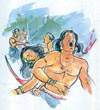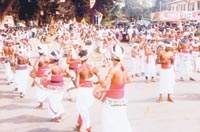|
King
Devanampiyatissa's friend Emperor Asoka King Chandragupta succeeded in defeating Dhana-Nanda, the last of the Nanda kings. In the task of empire building, Chandragupta was assisted by the Brahmin Chanakya. His empire spread as far as the River Narmada on one side and the Himalayan range and the Hindukush mountains on the other. The land of Punjab and Kabul were at this time under Greek rule. The Greeks were led by Megasthenes. When the Greek
armies were defeated, they retreated. As a result of Greeks and
Indians living together, there was an exchange of ideas. Indians
learnt the art of sculpture and mathematics from the Greeks and
the Greeks, in turn, learnt the Indian arts. The Greeks entered
in to an alliance with Chandragupta and handed back whatever It is recorded that Chandragupta lived as a 'Jaina mendicant' in the last days of his life. When he passed away in 292 BC, he was succeeded by his son Bindusara. He too continued friendly relations with the Greeks. He is supposed to have had relations with Syria and an envoy of the king of Syria has occupied a place in his court. King Bindusara
is supposed to have had 101 sons and Asoka is just one of them.When
the father was ruling from the capital city, Asoka was the ruler
of Ujjaini. When Bindusara died in 273BC, his eldest son Sumana
has succeeded him. But Asoka is said to have killed all his brothers
to gain the kingdom. The four years of his rule, before his consecration
, may stand as evidence for the period of unrest in the empire.
Asoka was consecrated in 269 BC. Once he ascended the throne, he
too began to expand his empire. The boundaries of his empire were,
Gandhasa in the N.W., Kamarupa in the In the 8th year of his consecration - in 261 BC, Asoka invaded Kalinga. The army of the ruler of Kalinga was equally powerful and a severe battle followed. Asoka became victorious. Thousands died on the battlefield. Some more thousands were imprisoned. Asoka was greatly moved by the damage done. He sought the help of the Brahmins to console himself. He gave them alms daily. On seeing the conduct of these Brahmins, Asoka got disgusted. Once, when
Asoka was looking out from his balcony, he noticed a young samanera
(a novice monk), walking along the road. He was taken up by the
disciplined nature of this young priest. He invited him into the
palace and requested him to occupy a suitable seat. The young priest
sat on the throne. Taken aback by his behaviour, the king asked
him who he was. "Oh! Great king! As a layman, I was the son
of King Sumana", said Asoka then understood the connection and inquired where he grew up. "Oh! King, when you killed my father, my mother fled to the forest in fear. There she gave birth to me, under a banyon tree. The people of the Chandala clan, who lived in the forest, cared for us. As I was born under a banyon tree, I was named 'Nigrodha'", continued the priest. Asoka patiently listened to all this. The young prince then got up from the throne and said, "King, I sat on the throne because if I remained a layman, I should have been the rightful claimant. But, now that I am a priest, it does not belong to me. I'm now a son of the Buddha". The king offered alms to the priest and the priest preached the Dhamma to him. Being quite consoled, the king asked him where he was proceeding to. The young priest said he was on his way to see his mother. When
the 'Perahera' was high fun for the villagers In the early
days, the 'perahera' had been much more elaborate than what we see
now. It was also a form of entertainment for the villagers, particularly
for the girls. Author Martin Wickramasinghe relates how when one
village held a Pirith chanting ceremony at the temple, it was customary
for the people of the adjoining village to come in procession with
dancers and drummers to offer a 'Tree of Coins'. The 'perahera'
is advertised through hand-written posters giving the date and time
at which the procession would start, pasted on the coconut palms
on either side of the road, and also proclaimed to the beat of the
herald's drum ('anda beraya'). Getting ready
for the 'perahera' is an elaborate affair. "The girls of the
village, both rich and poor, had sufficient time to buy and sew
for themselves new jackets and clothes for the occasion, while those
who belonged to frugal families washed and pressed their old clothes
and jackets. Girls too poor to possess any jewellery would persuade
a parent or brother to visit some relatives in a distant village
in order to borrow hairpins, earrings and necklaces of gold or gilt
beads so that they might be in readiness to display to the full
their clothes, their ornaments and their beauty on the Perahera
day". The path taken
by the procession would be made ready thus: "On either side
of the high road strewn with white sand and bordered with strings
of tender yellow coconut-leaflets ('gokkola') strung on poles struck
into the ground at intervals, gathered the people: little boys and
girls, young women and youths, old men and women, and servants stood
waiting there. Every youth in the village would be out on the road,
dressed with an elegance equal to any girl's, his hair oiled and
combed till it gleamed. Some would take their stance near a group
of pretty girls and enjoy a view of that beauty till the Perahera
passed. Others would not stand still in one place, but like connoisseurs
at a picture gallery, walked along the road, viewing the beauties
on either hand". And now on
to how the procession proceeded: "The 'Soldier' masked and
dressed in a tattered coat and pair of trousers, was a herald of
the approaching procession. As they saw him, the people gathered
at the roadside would stop their talk and open to the fullest the
doors of those sense perceptions, which had hitherto only stood
ajar. Following him came the procession, slowly unfolding and flowing
like a stream of spectacular diversions to please the mind and sight
of the beholders. The actual procession began with the 'Surveyor'
and his 'apprentice' who followed the 'Soldier'. The 'Surveyor'
who wore European dress and a pair of coloured spectacles over his
whitened face provided the onlookers with amusement. The men who
sat in a decorated cart playing the 'rabana' and disguised as women
may have drawn laughter from the women in the audience, but not
from the men. A little boy who wore only a strip of cloth and was
liberally daubed with soot sat grimacing on a tree fastened to a
cart. Nobody could agree whether he was supposed to represent a
Veddah or a monkey, for the argument stemmed from the fact that
it wore no tail. Bullock carts served for floats which paraded spectacles
such as a devil dancing ceremony, a hotel or tea boutique and a
battleship. 'Riders' who supported tissue paper and bamboo effigies
of horses at waist level excited the laughter of both men and women.
The feats and somersaults of the tumblers fascinated everyone but
the sight of a 'murderer' dangling from the gallows fixed on a cart,
horrified the women and children". Then would
come a parade of mostly old women in white, bearing paper-flags
and slips of areca-blossom. The stilt-walkers, who stalked on legs
two fathoms high prompted the boys to try their luck the next day
trying to perform the same, by tying two stumps of kaduru-wood not
more than two feet long, on to their legs. |
||||
Copyright © 2001 Wijeya Newspapers
Ltd. All rights reserved. |
 envoy
landed there. The religious and the cultural aspects of our society
underwent change as a result of the influence of King Asoka. Hence,
King Asoka occupies an important place in our history too. With
the expansion of his kingdom, he became Emperor Asoka. He belonged
to the Maurya clan of kings, founded by Chandragupta - Maurya.
envoy
landed there. The religious and the cultural aspects of our society
underwent change as a result of the influence of King Asoka. Hence,
King Asoka occupies an important place in our history too. With
the expansion of his kingdom, he became Emperor Asoka. He belonged
to the Maurya clan of kings, founded by Chandragupta - Maurya. provinces
they had conquered. When Chandragupta was ruling from Pataliputra,
Megasthenes, the Greek envoy, was a member of his court in 305 BC.
Chandragupta divided his empire into three parts and appointed viceroys
to rule from the cities of Thakshila, Ujjaini and Thosali.
provinces
they had conquered. When Chandragupta was ruling from Pataliputra,
Megasthenes, the Greek envoy, was a member of his court in 305 BC.
Chandragupta divided his empire into three parts and appointed viceroys
to rule from the cities of Thakshila, Ujjaini and Thosali. east,
the Arabian Sea in the west and the River Krishna in the south.
east,
the Arabian Sea in the west and the River Krishna in the south. he.
"That can't be. He had no son", said the king. "You
are correct, but by the time my father was killed my mother was
expecting me. She was pregnant then", said the priest.
he.
"That can't be. He had no son", said the king. "You
are correct, but by the time my father was killed my mother was
expecting me. She was pregnant then", said the priest. roadside
to watch it. The drummers are followed by dancers, who are clad
in their costumes and march forward while performing.
roadside
to watch it. The drummers are followed by dancers, who are clad
in their costumes and march forward while performing.